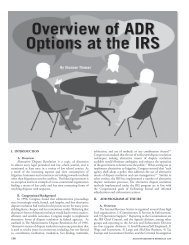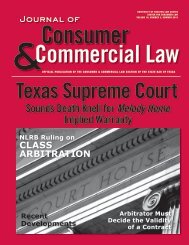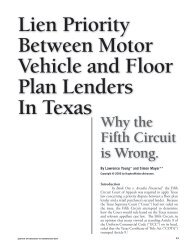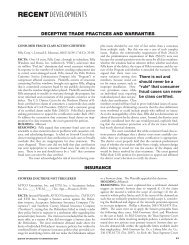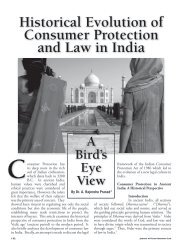Teaching Consumer Credit Law in an Evolving Australian Economy
Teaching Consumer Credit Law in an Evolving Australian Economy
Teaching Consumer Credit Law in an Evolving Australian Economy
You also want an ePaper? Increase the reach of your titles
YUMPU automatically turns print PDFs into web optimized ePapers that Google loves.
D. Case <strong>Law</strong> That Gets it Wrong<br />
This seems to be a case where one Court got it wrong <strong>an</strong>d the<br />
others are read<strong>in</strong>g head-notes or otherwise fail<strong>in</strong>g to make <strong>an</strong><br />
<strong>in</strong>dependent <strong>an</strong>alysis. The task of the courts is to <strong>an</strong>alyze the<br />
law with <strong>an</strong> emphasis on proper pr<strong>in</strong>ciples of statutory construction.<br />
A critical exam<strong>in</strong>ation of section subsection 17.50(h) is<br />
long overdue.<br />
The pla<strong>in</strong> l<strong>an</strong>guage of the tie-<strong>in</strong> provision makes the DTPA<br />
available to pla<strong>in</strong>tiffs other th<strong>an</strong> just consumers, yet the clear <strong>in</strong>tent<br />
of the legislature is under attack by a number of courts who<br />
have glossed over the direct <strong>an</strong>d unambiguous l<strong>an</strong>guage of the<br />
tie-<strong>in</strong> authority found <strong>in</strong> subsection 17.50(h) <strong>an</strong>d have bl<strong>in</strong>dly<br />
followed the oversimplified m<strong>an</strong>tra that the DTPA requires consumer<br />
status. 53<br />
If the stakes were not so very high, the <strong>in</strong>artful <strong>an</strong>alysis that<br />
has lead to a number of Texas Federal Courts <strong>an</strong>d a couple of<br />
State Courts to get this wrong would be comical. Unfortunately,<br />
each of the decisions has a pla<strong>in</strong>tiff be<strong>in</strong>g denied some remedy<br />
that should be available <strong>an</strong>d so rather th<strong>an</strong> comical the entire<br />
movement is tragic. What started out as one Court mis<strong>in</strong>terpret<strong>in</strong>g<br />
a statute has snowballed <strong>in</strong>to <strong>an</strong> unfortold trend that ignores<br />
the clear l<strong>an</strong>guage of the statute.<br />
The story beg<strong>in</strong>s <strong>in</strong> the Federal District Court for the<br />
Northern District of Texas with the decision <strong>in</strong> Marketic v. U. S.<br />
B<strong>an</strong>k Nat’l Ass’n. The Marketic Court stated:<br />
Pla<strong>in</strong>tiff fails to recognize that Tex. Bus. & Com. Code<br />
§ 17.50(h) does not exempt claim<strong>an</strong>ts from show<strong>in</strong>g<br />
that they qualify as a “consumer” under Tex. Bus. &<br />
Com. Code § 17.45(4). In all cases, a pla<strong>in</strong>tiff must<br />
qualify as a “consumer” <strong>in</strong> order to have st<strong>an</strong>d<strong>in</strong>g to br<strong>in</strong>g<br />
<strong>an</strong> action under the DTPA. 54<br />
Interest<strong>in</strong>gly, section 17.45 is the def<strong>in</strong>itions section of the<br />
DTPA. Section 17.45(4) simply supplies the def<strong>in</strong>ition of consumer.<br />
It places no requirement to be a consumer under the<br />
DTPA. The consumer requirement comes from section 17.50(a)<br />
which states that “A consumer may ma<strong>in</strong>ta<strong>in</strong> <strong>an</strong> action where<br />
<strong>an</strong>y of the follow<strong>in</strong>g constitute a produc<strong>in</strong>g cause of economic<br />
damages or damages for mental <strong>an</strong>guish...” 55 This is the primary<br />
gr<strong>an</strong>t of authority to br<strong>in</strong>g a direct action under the DTPA <strong>an</strong>d<br />
it does require consumer status for direct claims, but this by no<br />
me<strong>an</strong>s limits other parts of the Act from allow<strong>in</strong>g <strong>an</strong> action to<br />
be brought by persons other th<strong>an</strong> a consumer under the DTPA<br />
where authorized. In other words, 17.50(a) does not preclude<br />
non-consumers from br<strong>in</strong>g<strong>in</strong>g actions, but rather gr<strong>an</strong>ts authority<br />
for consumers to br<strong>in</strong>g actions.<br />
The cases that are cited to by the Marketic Court, <strong>in</strong>clud<strong>in</strong>g<br />
Mendoza <strong>an</strong>d Figueroa, are both cases that <strong>in</strong>volved direct<br />
claims under 17.50(a) <strong>an</strong>d thus actually did require consumer<br />
status. 56 Tie-<strong>in</strong> statutes were not even <strong>in</strong>volved <strong>in</strong> these cases. Tie<strong>in</strong><br />
statutes get their gr<strong>an</strong>t of authority to br<strong>in</strong>g a cause of action<br />
under the DTPA from 17.50(h) not 17.50(a). Subsection “(h)”,<br />
<strong>in</strong> a separate <strong>an</strong>d dist<strong>in</strong>ct gr<strong>an</strong>t of authority dispenses with the<br />
“consumer” requirement found <strong>in</strong> subsection “(a)” <strong>an</strong>d <strong>in</strong>stead<br />
focuses on the <strong>in</strong>tent as expressed <strong>in</strong> <strong>an</strong>other law to allow claims<br />
for violations of that law to be brought through the DTPA. This<br />
does not prevent a consumer from seek<strong>in</strong>g redress under subsection<br />
(h); it simply dispenses with the requirement of consumer<br />
status under the DTPA <strong>an</strong>d substitutes the st<strong>an</strong>d<strong>in</strong>g requirements<br />
as expressed <strong>in</strong> the enabl<strong>in</strong>g l<strong>an</strong>guage of each tie-<strong>in</strong> statute. Such<br />
a read<strong>in</strong>g of co-existent rights to br<strong>in</strong>g <strong>an</strong> action is compatible<br />
with the l<strong>an</strong>guage of the statute <strong>an</strong>d apparent by the enabl<strong>in</strong>g<br />
l<strong>an</strong>guage of the various tie-<strong>in</strong> statues.<br />
The l<strong>in</strong>e of cases 57 follow<strong>in</strong>g the Marketic case signific<strong>an</strong>tly<br />
limit the application of a tie-<strong>in</strong> statute, the Texas Debt Collections<br />
Act, yet when properly <strong>an</strong>alyzed, the cited precedents do<br />
not st<strong>an</strong>d for the propositions for which they are cited. Rather<br />
th<strong>an</strong> mak<strong>in</strong>g <strong>an</strong> <strong>in</strong>dependent <strong>an</strong>alysis under the rules of construction,<br />
even the Fifth Circuit Court of Appeals has climbed on the<br />
b<strong>an</strong>dwagon, 58 as has the S<strong>an</strong> Antonio Court of Appeals. 59 There<br />
is a general proposition regard<strong>in</strong>g DTPA st<strong>an</strong>d<strong>in</strong>g <strong>an</strong>d it is based<br />
upon the premise that a pla<strong>in</strong>tiff must br<strong>in</strong>g a claim under section<br />
17.50(a). However, the broader l<strong>an</strong>guage under section 17.50(h)<br />
unequivocally allows a “claim<strong>an</strong>t” to br<strong>in</strong>g <strong>an</strong> action under the<br />
DTPA for a violation of a tie-<strong>in</strong> statute. If a statute is unambiguous,<br />
we seek the <strong>in</strong>tent of the legislature as found <strong>in</strong> the pla<strong>in</strong> <strong>an</strong>d<br />
common me<strong>an</strong><strong>in</strong>g of the words <strong>an</strong>d terms used. 60 Section 17.50(h)<br />
provides that <strong>an</strong><br />
“act or practice<br />
that is a violation<br />
of a provision<br />
of law<br />
other th<strong>an</strong> this<br />
subchapter may<br />
be made the basis<br />
of <strong>an</strong> action<br />
under this subchapter<br />
if the<br />
act or practice is<br />
proscribed by a<br />
provision of this<br />
subchapter or is<br />
The most logical way<br />
to read the l<strong>an</strong>guage of<br />
17.50(h) is to underst<strong>an</strong>d<br />
that the legislature <strong>in</strong>tended<br />
for the DTPA provisions to<br />
be available to pla<strong>in</strong>tiffs<br />
other th<strong>an</strong> consumers when<br />
<strong>an</strong>other law <strong>in</strong>tends for<br />
violation to be actionable<br />
under the DTPA.<br />
declared by such other law to be actionable under this subchapter.”<br />
61 Courts should simply apply this l<strong>an</strong>guage.<br />
E. Analysis of a 17.50(h) Claim<br />
1. “Claim<strong>an</strong>t” is Def<strong>in</strong>ed by the Tie-In not the DTPA<br />
The l<strong>an</strong>guage of 17.50(h) states “if a claim<strong>an</strong>t is gr<strong>an</strong>ted the right<br />
to br<strong>in</strong>g a cause of action under this subchapter by <strong>an</strong>other law...”<br />
Nowhere <strong>in</strong> the Marketic decision does the Court recognize this<br />
l<strong>an</strong>guage, yet Marketic <strong>an</strong>d its progeny simply equate the word<br />
claim<strong>an</strong>t with consumer, <strong>an</strong>d fail to address or otherwise disclose<br />
why the legislature did not use the word consumer if that<br />
is what it me<strong>an</strong>t. This read<strong>in</strong>g completely ignores the fact that<br />
the legislature could have said consumer if that is what it me<strong>an</strong>t,<br />
but it did not. Thus a claim<strong>an</strong>t must be someth<strong>in</strong>g different th<strong>an</strong><br />
a consumer.<br />
The most logical way to read the l<strong>an</strong>guage of 17.50(h) is to<br />
underst<strong>an</strong>d that the legislature <strong>in</strong>tended for the DTPA provisions<br />
to be available to pla<strong>in</strong>tiffs other th<strong>an</strong> consumers when <strong>an</strong>other<br />
law <strong>in</strong>tends for violation to be actionable under the DTPA. So to<br />
<strong>an</strong>swer “what is a claim<strong>an</strong>t” one must look to the referr<strong>in</strong>g statute<br />
<strong>an</strong>d the <strong>an</strong>swer will vary depend<strong>in</strong>g upon which statute ties <strong>in</strong>to<br />
the DTPA. A “Claim<strong>an</strong>t” is not specifically def<strong>in</strong>ed under the<br />
DTPA other th<strong>an</strong> generally as one gr<strong>an</strong>ted to br<strong>in</strong>g a claim under<br />
the DTPA by <strong>an</strong>other statute because it is not a static def<strong>in</strong>ition<br />
like consumer but rather a dynamic def<strong>in</strong>ition that will be different<br />
depend<strong>in</strong>g upon which tie-<strong>in</strong> statute is be<strong>in</strong>g referenced. The<br />
court is obligated to look to the enabl<strong>in</strong>g l<strong>an</strong>guage of the specific<br />
tie-<strong>in</strong> statute to ascerta<strong>in</strong> the Legislature’s <strong>in</strong>tent as to what<br />
group of persons is a claim<strong>an</strong>t with respect to this tie-<strong>in</strong> statute.<br />
In those situations where<strong>in</strong> a claim<strong>an</strong>t under a tie-<strong>in</strong> is not a consumer<br />
under the DTPA, there are still m<strong>an</strong>y similarities between<br />
the groups such as unequal barga<strong>in</strong><strong>in</strong>g power, lack of knowledge<br />
<strong>an</strong>d the perception of generally be<strong>in</strong>g the weak party. The greatest<br />
commonality is the apparent Legislative <strong>in</strong>tent for both groups to<br />
be conferred st<strong>an</strong>d<strong>in</strong>g under the DTPA. Thus the same justifications<br />
that lead to a need to level the play<strong>in</strong>g field for consumers<br />
will apply to claim<strong>an</strong>ts under 17.50(h).<br />
An evaluation of a number of typical tie-<strong>in</strong> statutes follows<br />
to demonstrate the <strong>an</strong>alysis <strong>an</strong>d emphasize the differences be-<br />
Journal of <strong>Consumer</strong> & Commercial <strong>Law</strong> 21



